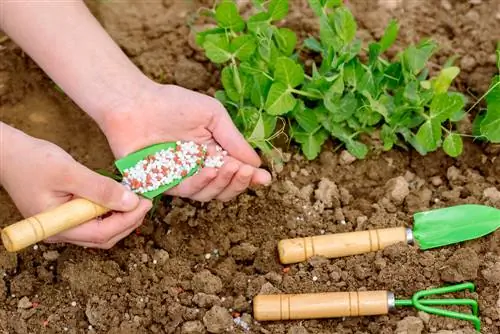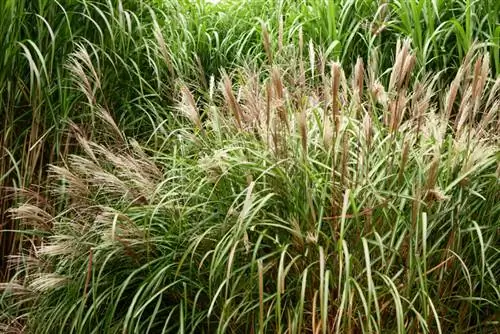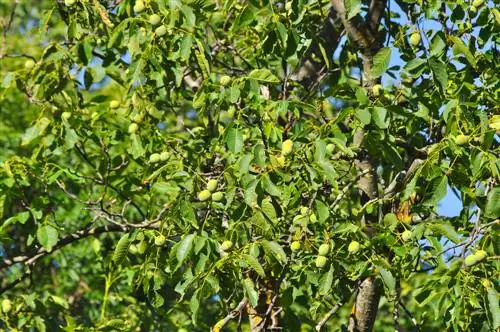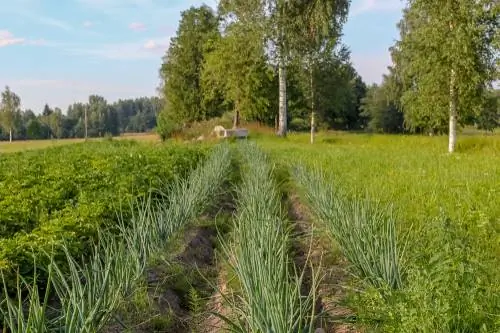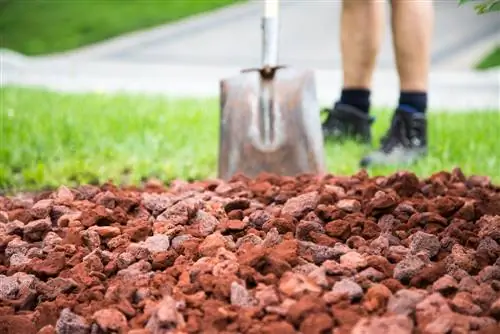- Author admin [email protected].
- Public 2023-12-26 14:17.
- Last modified 2025-01-23 11:22.
Liquid fertilizer, NPK fertilizer, complete fertilizer - there are countless fertilizer mixtures on the market that differ greatly in their composition, application and quality. This article will help you find your way through the jungle of numerous offers.

What is a complete fertilizer?
Complete fertilizers are fertilizers that contain the three main nutrients nitrogen (N), phosphorus (P) and potassium (K). They promote the growth of shoots, flower formation and fruit development as well as the resistance of the plants. Complete fertilizers can be mineral, organic or organo-mineral and vary in composition, application and quality.
- Fertilizers contain the main nutrients nitrogen, phosphorus and potassium in different compositions depending on the product.
- Depending on the product, the composition also differs with other nutrients and trace elements.
- A distinction is made between mineral, organic and mineral-organic complete fertilizers.
- Each type of fertilizer has its specific advantages and disadvantages.
- Depending on the ingredients and composition, complete fertilizers are not suitable for sole fertilization.
What is complete fertilizer?

Every soil that is used for gardening or agriculture must be fertilized - after all, the plants growing on it remove valuable nutrients from the soil. As vegetables and grains are harvested and lawns are mowed, the extracted nutrients do not get back into the soil and have to be added artificially. A complete fertilizer contains the most important elements that plants use most during their growth.
Mainly these are the substances nitrogen, phosphorus and potassium, which are particularly important for plant growth. They each support three growth areas:
- Nitrogen: is abbreviated with the letter “N”, promotes the growth of shoots and branches, is important for photosynthesis
- Phosphorus: is abbreviated with the letter “P”, promotes flower formation and fruit development
- Potassium: abbreviated “K”, promotes the resistance of plants to diseases, pests as well as frost and drought
Complete fertilizers are used in various areas. They are indispensable in agriculture as well as in home and hobby gardens as well as for pot, aquarium and terrarium plants. They are available in both granular and, for home use, liquid form.
Composition
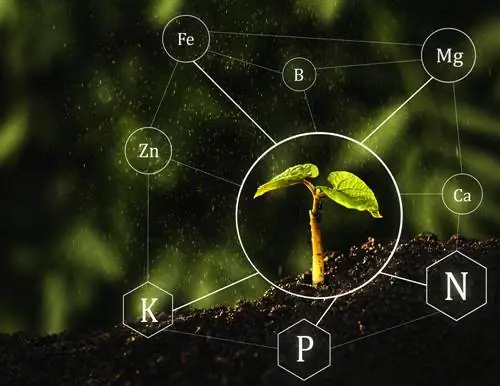
Just like us, plants also need various minerals
Nitrogen, phosphorus and potassium are the three most important nutrients that plants need in larger quantities. Other main elements that are also important but needed in smaller quantities are magnesium (Mg), calcium (Ca) and sulfur (S). They are also an indispensable component of every complete fertilizer.
Not every complete fertilizer contains so-called trace elements, which are only necessary in tiny quantities. Minerals such as boron (B), chlorine (Cl), iron (Fe), copper (Cu), manganese (Mn), molybdenum (Mo), nickel (Ni) and zinc (Zn) must therefore be used occasionally, depending on the type of fertilizer chosen be additionally fertilized.
The package description of the complete fertilizer provides information about which nutrients are present and in what quantities. Here the content information is always given in percent, whereby the notation is usually as follows: 15/15/15 means that nitrogen, phosphorus and potassium are each contained in the fertilizer at 15 percent. Blaukorn, a popular complete mineral fertilizer, is composed in a ratio of 12/12/17 + 2. Since the main nutrients are always listed as follows: N - P - K - Mg - S, this means for blue grain: 12 percent nitrogen, 12 percent phosphorus, 17 percent potassium and 2 percent magnesium. Any other ingredients present will be listed separately.
What types of complete fertilizers are there?
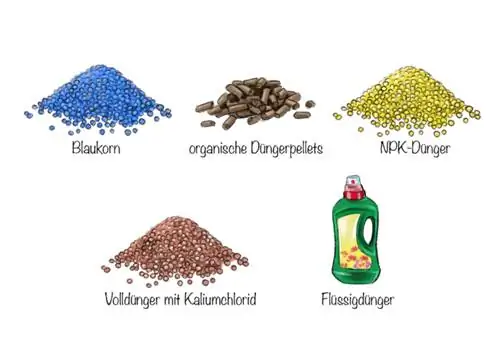
Basically, there are three forms of complete fertilizers, which differ in their composition and mode of action.
| Complete fertilizer | Origin | Shape | Advantages | Disadvantages |
|---|---|---|---|---|
| Complete mineral fertilizers | synthetic, artificial fertilizer | dissolved as fertilizer s alt or liquid fertilizer | fast effective, needs-based fertilization (for long-term fertilizers) | difficult dosage, over-fertilization can be done quickly, no positive effect on soil life and humus formation |
| Organic complete fertilizers | plant and animal raw materials | in solid or liquid form | Nutrients are released slowly, positive influence on soil life and humus formation | No targeted and quick-acting fertilization is possible for special needs (e.g. a nutrient deficiency), precise planning makes sense |
| Organic-mineral complete fertilizers | both synthetic and organic starting materials | in solid or liquid form | combine advantages of both types of fertilizer | combine disadvantages of both types of fertilizer |
In your home garden, you should prefer organic complete fertilizers instead of synthetic fertilizers such as blue grain. Mineral fertilizers have to be added again and again because they have no humus-forming influence on the soil - they are simply used up immediately or end up in the groundwater. Organic complete fertilizers, in turn, stimulate soil life and ensure that nutrient-rich humus is formed. In addition, over-fertilization is difficult here, as the nutrients are only released to the plants gradually.
Excursus
Are complete fertilizers and NPK fertilizers the same thing?
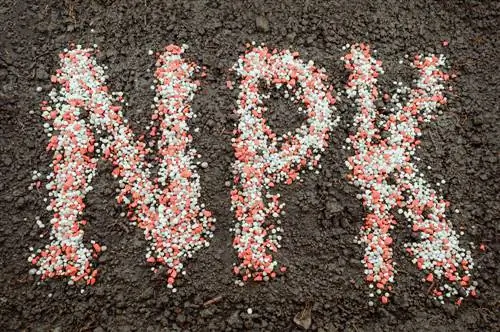
Various NPK fertilizers differ in their composition
Since every NPK fertilizer contains the three main nutrients nitrogen, phosphorus and potassium, it is also a complete fertilizer. But here too the composition varies greatly between the individual products. Some NPK fertilizers actually only contain these three components, while other NPK complete fertilizers contain all the important elements.
Advantages and disadvantages
“Always prefer organic to mineral fertilizers, as these support humus formation.”
Some of the most important advantages and disadvantages have already been discussed in the previous point, this table should now give you an overview of further distinguishing features.
| Advantages | Disadvantages | |
|---|---|---|
| Organic complete fertilizers | Overfertilization not possible | more expensive than artificial fertilizer |
| Improving soil life and humus formation | no quick nutrient balancing possible | |
| Slow action, nutrients are released gradually, long-term effect | often contains too little potassium | |
| Use of natural raw materials | ||
| Complete mineral fertilizers | act very quickly, nutrients are available to plants immediately | Rapid availability also means risk of over-fertilization: This results in damage to plants and the environment |
| high nutrient concentration | Danger of over-fertilization: This results in plant and environmental damage | |
| cheap price | Environmental damage caused by raw material extraction and manufacturing process | |
| some products with long-term effects | negative influence on soil life and humus formation |
Complete mineral fertilizers are not sufficient for plant supply
It is also important to note that complete mineral fertilizers in particular often do not contain all the necessary nutrients and therefore additional fertilizers must be applied. This applies, for example, to lime fertilization, for example on lawns. Lime is nothing other than calcium, which is primarily used to combat soil acidification. However, you should never fertilize and lime your lawn at the same time, but rather apply the lime in autumn or early spring and the complete fertilizer at least four weeks later. There are various reasons for this:
- Calcium reacts to form ammonia and water-insoluble phosphorus, so that the nutrients are not available to the plants as desired
- Fertilizers applied to soils with a low pH value also have limited plant availability because the plants cannot absorb them
- that's why the rule of thumb is: first increase the pH value by liming, then fertilize
But occasional top-up fertilization may also be necessary for other nutrients, for example because chlorosis caused by iron deficiency can occur due to a sole supply of a complete mineral fertilizer.
Application
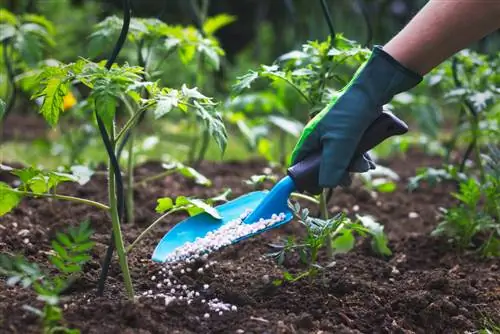
Every plant has its own nutritional needs
When using any complete fertilizer correctly, various aspects must be taken into account in order to keep the disadvantages and possible damage mentioned as small as possible and to keep the desired result as comprehensive as possible.
- Don't just randomly apply a single fertilizer to the entire garden.
- Remember: Every plant has its specific needs in terms of nutrient composition.
- The soil and its composition are not the same in every corner of the garden.
- This means that different fertilizer doses are necessary depending on the soil composition and planting.
- Basically, vegetable and fruit plants have a higher nutrient requirement than summer flowers and other ornamental plants. Woody plants also need to be fertilized less frequently.
- So you have to create a plan throughout the gardening season as to when which garden areas need to be supplied with which fertilizer and at what intervals.
Please note that complete fertilizer is in a highly concentrated form, which you must first dilute before each application. This is easier with liquid fertilizers because you can measure them well and mix them with the irrigation water. Be sure to follow the instructions on dosage and application given on the packaging. Measure the required amounts precisely and apply them evenly - so that when fertilizing the lawn, for example, some areas receive a lot of fertilizer and others too little. Both lead to unsightly damage to the lawn, for example through burning or short growth.
These rules also apply when applying complete fertilizers:
- fertilize in the early morning or evening if possible
- never in the hot midday sun as this can cause fertilizer burns
- do not fertilize in strong winds
- Do not fertilize on dry soil, ideally after a rain shower or after watering
- Distribute fertilizer evenly (e.g. with the help of a spreader (€23.00 on Amazon))
- Apply fertilizer directly to the soil, do not sprinkle or water over the plants
You should also read the manufacturer's safety instructions carefully, as many fertilizers are toxic and / or can cause chemical burns to the skin.
Excursus
Order a soil sample before fertilization
In addition, before using a complete fertilizer, it makes sense to determine whether and which nutrients the soil is missing. Many garden soils are over-fertilized, which is why uncontrolled fertilization causes damage to both your plants and your soil. You should therefore arrange for a soil analysis every two to three years, in which a specialized institute determines the composition of your soil. With the evaluation you will find out which nutrients are abundant and which you need to add through targeted fertilization. With these specially tailored fertilizer instructions you will be able to supply your plants according to their needs.

Frequently asked questions
What do you have to consider when fertilizing grassland?
When fertilizing grassland, various other aspects of fertilization must be taken into account. For example, a hay meadow needs to be fertilized differently than a cow or horse pasture. Cows and horses automatically provide a certain level of basic fertilization with their excrement, while regularly mown meadows suffer a nutrient deficiency over time.
The basic recommendation for both is to use an NPK complete fertilizer with sulfur. This increases the protein and energy content of the vegetation. Meadows that are not grazed should also receive fertilizer with a higher nitrogen content. Further information can be found in the respective fertilizer regulations.
Can you make complete fertilizer yourself?
Of course you don't have to buy complete fertilizer. Instead, a garden can be made very well with organic materials such as compost, (rotted) manure, horn shavings and meal, primary rock powder and garden lime. The disadvantage, however, is that you have no overview of the exact nutrients and their proportions.
Tip
Some gardeners also swear by fertilizing with home-made plant manure, especially from nettles.

